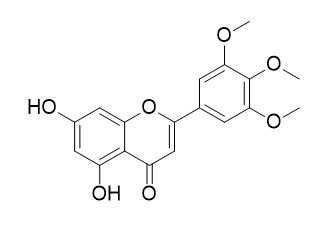5,7-Dihydroxy-3',4',5'-trimethoxyflavone is a natural product from Centaurea scoparia.
Providing storage is as stated on the product vial and the vial is kept tightly sealed, the product can be stored for up to
24 months(2-8C).
Wherever possible, you should prepare and use solutions on the same day. However, if you need to make up stock solutions in advance, we recommend that you store the solution as aliquots in tightly sealed vials at -20C. Generally, these will be useable for up to two weeks. Before use, and prior to opening the vial we recommend that you allow your product to equilibrate to room temperature for at least 1 hour.
Need more advice on solubility, usage and handling? Please email to: service@chemfaces.com
The packaging of the product may have turned upside down during transportation, resulting in the natural compounds adhering to the neck or cap of the vial. take the vial out of its packaging and gently shake to let the compounds fall to the bottom of the vial. for liquid products, centrifuge at 200-500 RPM to gather the liquid at the bottom of the vial. try to avoid loss or contamination during handling.
ScientificWorldJournal. 2014;2014:274207.
Cytotoxic activities of flavonoids from Centaurea scoparia.[Pubmed:
25114960 ]
METHODS AND RESULTS:
Phytochemical studies on the ethanolic extract of the aerial parts of Centaurea scoparia led to the isolation of two new flavonoids, 3',4'-dihydroxy-(3'',4''-dihydro-3''-hydroxy-4''-acetoxy)-2'',2''-dimethylpyrano-(5'',6'':7,8)-flavone-3-O- β -D-glucopyranoside (1) and 3,3',4'-trihydroxy-(3'',4''-dihydro-3'',4''-dihydroxy)-2'',2''-dimethylpyrano-(5'',6'':7,8)-flavone (2), along with eight known flavonoids isolated for the first time from this plant, cynaroside (3), Apigetrin (4), centaureidin (5), oroxylin A (6), 5,7-Dihydroxy-3',4',5'-trimethoxyflavone (7), atalantoflavone (8), 5-hydroxy-3',4',8-trimethoxy-2'',2''-dimethylpyrano (5'',6'':6,7)-flavone (9), and 3',4',5,8-tetramethoxy-2'',2''-dimethylpyrano (5'',6'':6,7)-flavone (10). The structures of the isolated compounds were elucidated by means of spectroscopic tools including 1D and 2D NMR, UV, IR, and mass spectroscopy.
CONCLUSIONS:
Cytotoxic activities of the isolated compounds were evaluated against human cervical carcinoma HeLa, human hepatocellular carcinoma HepG2, and human breast carcinoma MCF-7. Compound 2 was the most potent cytotoxic agent against HeLa cells with an IC50 0.079 μM.



